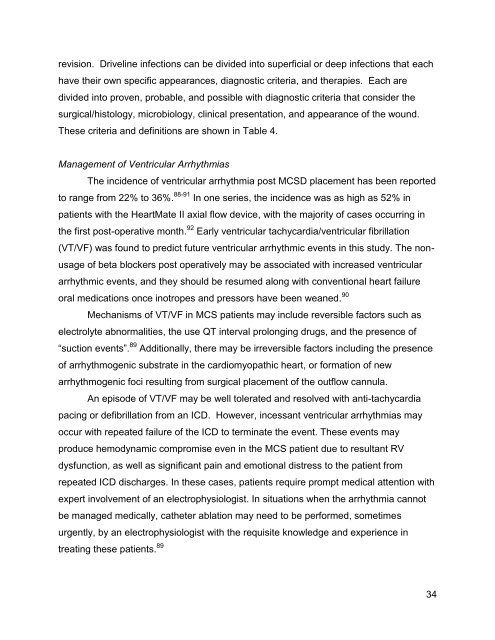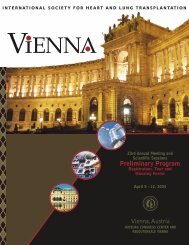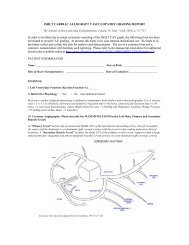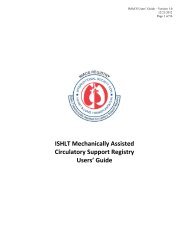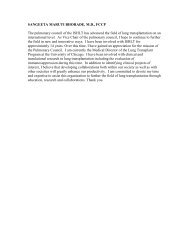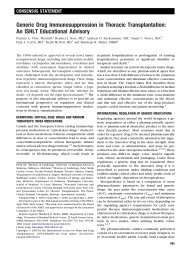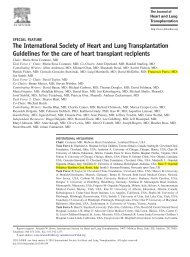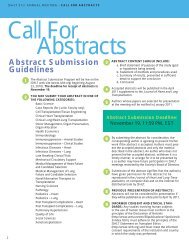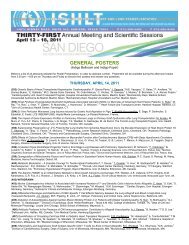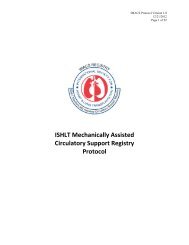Task Force 4: Inpatient Management of Patients with MCSD - The ...
Task Force 4: Inpatient Management of Patients with MCSD - The ...
Task Force 4: Inpatient Management of Patients with MCSD - The ...
Create successful ePaper yourself
Turn your PDF publications into a flip-book with our unique Google optimized e-Paper software.
evision. Driveline infections can be divided into superficial or deep infections that each<br />
have their own specific appearances, diagnostic criteria, and therapies. Each are<br />
divided into proven, probable, and possible <strong>with</strong> diagnostic criteria that consider the<br />
surgical/histology, microbiology, clinical presentation, and appearance <strong>of</strong> the wound.<br />
<strong>The</strong>se criteria and definitions are shown in Table 4.<br />
<strong>Management</strong> <strong>of</strong> Ventricular Arrhythmias<br />
<strong>The</strong> incidence <strong>of</strong> ventricular arrhythmia post <strong>MCSD</strong> placement has been reported<br />
to range from 22% to 36%. 88-91 In one series, the incidence was as high as 52% in<br />
patients <strong>with</strong> the HeartMate II axial flow device, <strong>with</strong> the majority <strong>of</strong> cases occurring in<br />
the first post-operative month. 92 Early ventricular tachycardia/ventricular fibrillation<br />
(VT/VF) was found to predict future ventricular arrhythmic events in this study. <strong>The</strong> nonusage<br />
<strong>of</strong> beta blockers post operatively may be associated <strong>with</strong> increased ventricular<br />
arrhythmic events, and they should be resumed along <strong>with</strong> conventional heart failure<br />
oral medications once inotropes and pressors have been weaned. 90<br />
Mechanisms <strong>of</strong> VT/VF in MCS patients may include reversible factors such as<br />
electrolyte abnormalities, the use QT interval prolonging drugs, and the presence <strong>of</strong><br />
“suction events”. 89 Additionally, there may be irreversible factors including the presence<br />
<strong>of</strong> arrhythmogenic substrate in the cardiomyopathic heart, or formation <strong>of</strong> new<br />
arrhythmogenic foci resulting from surgical placement <strong>of</strong> the outflow cannula.<br />
An episode <strong>of</strong> VT/VF may be well tolerated and resolved <strong>with</strong> anti-tachycardia<br />
pacing or defibrillation from an ICD. However, incessant ventricular arrhythmias may<br />
occur <strong>with</strong> repeated failure <strong>of</strong> the ICD to terminate the event. <strong>The</strong>se events may<br />
produce hemodynamic compromise even in the MCS patient due to resultant RV<br />
dysfunction, as well as significant pain and emotional distress to the patient from<br />
repeated ICD discharges. In these cases, patients require prompt medical attention <strong>with</strong><br />
expert involvement <strong>of</strong> an electrophysiologist. In situations when the arrhythmia cannot<br />
be managed medically, catheter ablation may need to be performed, sometimes<br />
urgently, by an electrophysiologist <strong>with</strong> the requisite knowledge and experience in<br />
treating these patients. 89<br />
34


